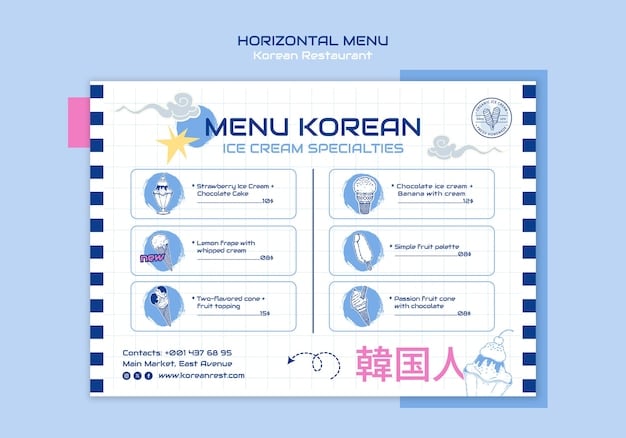Decoding Korean Honorifics: Your 2025 Guide for Americans

Decoding Korean honorifics is crucial for Americans navigating Korean culture in 2025, enhancing communication and preventing misunderstandings in both personal and professional settings.
Navigating the intricate world of Korean culture can be both exciting and daunting, especially when it comes to understanding and using honorifics. As cultural exchanges between the United States and Korea continue to grow, mastering these linguistic nuances becomes increasingly important. This comprehensive guide, “Decoding Korean Honorifics: A Practical Guide for Americans in 2025,” is designed to equip you with the knowledge and skills necessary to confidently engage in respectful and meaningful interactions.
Why Korean Honorifics Matter
Korean honorifics are more than just polite words; they are the cornerstone of social interactions in Korea. Understanding and using them correctly demonstrates respect, builds rapport, and fosters positive relationships. Neglecting them can lead to misunderstandings, unintentional offense, and damaged relationships, especially in professional settings.
The Role of Age and Status
Age and social status are primary determinants of honorific usage in Korean. Showing respect to elders and those in positions of authority is deeply ingrained in Korean culture. Failing to acknowledge these distinctions can be seen as disrespectful and undermine your credibility.
Building Stronger Relationships
By mastering Korean honorifics, you demonstrate a genuine interest in and respect for Korean culture. This can lead to deeper connections, increased trust, and more fulfilling personal and professional relationships. It shows that you’ve taken the time and effort to understand their customs, which is highly valued.

- Creating a Positive First Impression: Using proper honorifics from the start sets a respectful and professional tone.
- Avoiding Cultural Missteps: Accurate usage prevents accidental disrespect and potential embarrassment.
- Enhancing Communication: Understanding nuances ensures clear and respectful dialogue.
- Building Trust and Rapport: Demonstrates a genuine interest in Korean culture and customs.
Mastering Korean honorifics is an investment in your relationships and overall success in Korean interactions. It’s a skill that will continue to be valuable as cultural exchanges increase.
Key Honorific Titles and Terms
The Korean language encompasses a rich array of honorific titles and terms, each carrying specific connotations of respect and formality. Understanding these terms is essential for effective communication in various social and professional contexts.
Common Honorific Suffixes
One of the most common ways to show respect in Korean is by adding honorific suffixes to names. These suffixes vary depending on the relationship and status of the individuals involved. -ssi (씨) is a general honorific used for people you are not particularly close to, while -nim (님) is reserved for individuals of high status or those deserving of exceptional respect.
Addressing Family Members
Family terms in Korean are inherently honorific, and the specific term used depends on your relationship to the family member and their age relative to you. For example, older brother is referred to differently by males (hyung – 형) and females (oppa – 오빠), each showing a level of familiarity and respect.
- -ssi (씨): A general honorific used for peers or those you are not particularly close to.
- -nim (님): A high-level honorific used for superiors, customers, or those deserving great respect.
- hyung (형)/oppa (오빠): Terms for older brother used by males and females, respectively.
- eonni (언니)/nuna (누나): Terms for older sister used by females and males, respectively.
Using the correct titles and terms demonstrates your understanding and respect for Korean social hierarchy. Incorrect usage can lead to awkwardness or offense, so it’s important to learn and practice these distinctions.

Essential Phrases Using Honorifics
Beyond individual titles, constructing polite and respectful phrases is crucial in Korean. The level of formality in your language should match the situation and your relationship with the person you are addressing.
Greetings and Farewells
Basic greetings like “hello” (annyeonghaseyo – 안녕하세요) and “goodbye” (annyeonghi gaseyo/gyeseyo – 안녕히 가세요/계세요) have honorific forms. The specific farewell used depends on whether you are the one leaving or staying.
Introducing Yourself
When introducing yourself, use humble language to show respect. A common phrase is “Choe ireumeun [your name] imnida” (제 이름은 [your name]입니다), which translates to “My name is [your name].” Adding honorific particles like -imnida demonstrates politeness.
- 안녕하세요 (annyeonghaseyo): Hello (formal)
- 감사합니다 (gamsahamnida): Thank you (formal)
- 제 이름은 [your name]입니다 (Choe ireumeun [your name] imnida): My name is [your name] (formal)
- 잘 부탁드립니다 (jal butak드립니다): Please take care of me (formal, often used when introducing yourself)
Mastering these essential phrases allows you to navigate basic interactions with grace and respect. Pay attention to the context and your audience to choose the appropriate level of formality.
Navigating Different Social Contexts
The use of Korean honorifics varies depending on the social context, ranging from formal business meetings to casual interactions with friends. Understanding these nuances is key to successful communication and building strong relationships.
Business Settings
In professional environments, maintaining a high level of formality is crucial. Address superiors with -nim and use respectful language in all communications. Defer to senior colleagues and avoid overly familiar behavior.
Casual Interactions
With close friends and family, the level of formality can be relaxed. However, it’s still important to show respect, especially to elders. Using appropriate family terms and avoiding overly casual language demonstrates your consideration.
In business settings, always err on the side of formality until invited to use a more casual tone. Showing respect for hierarchy is highly valued in Korean professional culture.
Common Mistakes Americans Make
Americans new to Korean culture often make predictable mistakes when it comes to honorifics. Being aware of these pitfalls can help you avoid unintentional offense and improve your cross-cultural communication skills.
Using First Names Incorrectly
In Korean culture, addressing someone by their first name is generally reserved for close friends and family. Using first names with strangers or superiors can be seen as disrespectful. Always use titles or the last name with an honorific suffix until invited to do otherwise.
Ignoring Age Differences
Age is a significant factor in determining honorific usage. Failing to recognize and respect age differences can be a major cultural faux pas. Always use appropriate honorifics when addressing someone older than you.
- Using first names prematurely: Wait for an invitation before using someone’s first name.
- Ignoring age and status differences: Always use appropriate honorifics based on age and social standing.
- Using overly casual language in formal settings: Maintain a professional tone in business situations.
- Misunderstanding family terms: Learn the correct terms for different family members and use them appropriately.
By avoiding these common mistakes, you can demonstrate your cultural sensitivity and build stronger relationships with Koreans.
Tips for Mastering Korean Honorifics
Learning Korean honorifics takes time and effort, but with the right approach, you can master these essential linguistic nuances and communicate confidently in Korean society.
Practice Regularly
The best way to learn honorifics is through consistent practice. Engage in conversations with native speakers, watch Korean dramas and movies, and pay attention to how honorifics are used in different contexts.
Seek Feedback
Don’t be afraid to ask for feedback from native speakers. They can provide valuable insights into your honorific usage and help you correct any mistakes. Most Koreans will appreciate your effort to learn their language and culture.
Use Language Learning Apps
Many language learning apps offer lessons on Korean honorifics. These apps can provide structured instruction and interactive exercises to help you master the concepts. Some popular options include Duolingo, Memrise, and Talk To Me In Korean.
- Immerse yourself in Korean culture: Watch K-dramas, listen to Korean music, and engage with Korean media.
- Practice with native speakers: Find language partners or tutors who can provide feedback on your honorific usage.
- Use language learning apps and resources: Take advantage of online tools and courses to learn the rules and nuances of Korean honorifics.
- Be patient and persistent: Learning honorifics takes time and effort, so don’t get discouraged by mistakes.
With dedication and the right resources, you can achieve fluency in Korean honorifics and navigate Korean social contexts with confidence.
Future of Honorifics in a Globalized World
As the world becomes increasingly interconnected, the role and usage of honorifics are evolving. While maintaining respect for tradition is important, there’s also a growing recognition of the need for cross-cultural understanding and adaptation.
Adapting to Modern Communication Styles
In some contexts, especially in international business, there may be a greater emphasis on direct communication and less strict adherence to traditional honorifics. However, it’s always best to be mindful of cultural sensitivities and adapt your communication style accordingly.
The Importance of Cultural Sensitivity
Regardless of how honorific usage evolves, cultural sensitivity will remain paramount. Showing genuine respect for Korean customs and traditions will always be valued, even if the specific rules of honorifics become more flexible.
The key is to strike a balance between respecting tradition and adapting to modern communication styles. Showing genuine cultural sensitivity will always be appreciated.
| Key Concept | Brief Description |
|---|---|
| 🤝 Importance of Honorifics | Show respect, build rapport, and avoid misunderstandings. |
| 👵 Age and Status | Key factors determining honorific usage. |
| 🗣️ Essential Phrases | Greetings, farewells, and self-introductions. |
| 🌐 Cultural Sensitivity | Always be respectful and mindful of cultural norms. |
FAQ Section
▼
Learning Korean honorifics is crucial for showing respect and building positive relationships. Using them correctly demonstrates cultural sensitivity, which is highly valued in Korean society.
▼
One of the most common mistakes is using first names prematurely. In Korean culture, it’s important to wait for an invitation before addressing someone by their first name.
▼
Practice consistently by engaging in conversations with native speakers, watching Korean dramas, and using language learning apps. Seeking feedback from native speakers is also beneficial.
▼
-ssi is a general honorific used for people you are not particularly close to, while -nim is reserved for individuals of high status or those deserving exceptional respect.
▼
Yes, honorifics are generally more formal in business settings to maintain professionalism. In casual interactions with close friends and family, formality can be relaxed, but respect should still be shown.
Conclusion
As you prepare to engage with Korean culture in 2025, remember that mastering honorifics is an ongoing journey. By embracing the principles outlined in this guide, practicing consistently, and seeking opportunities for real-world interaction, you can confidently navigate Korean social contexts, build meaningful relationships, and demonstrate your respect for this rich and vibrant culture.





